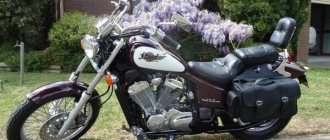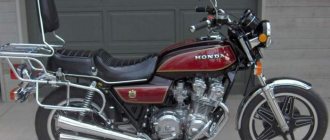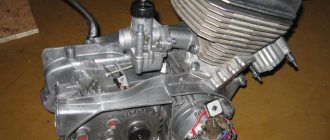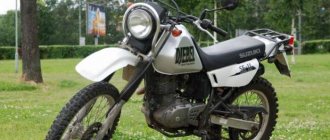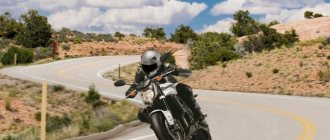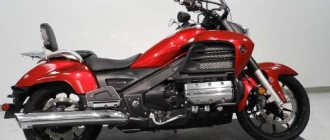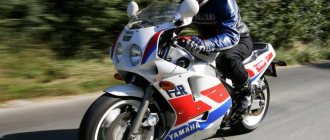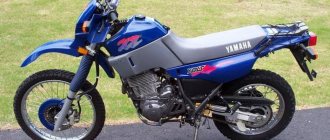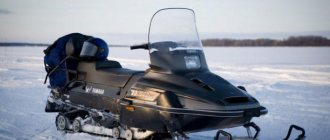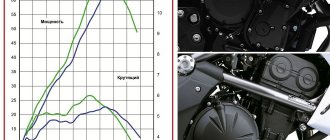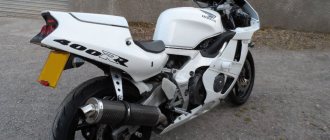V Max 1200
- motorcycle model, Yamaha brand
The Yamaha V-max 1200 power cruiser model was introduced in 1985, appearing for the first time on the North American market. The concept of the motorcycle featured cruiser features, a powerful 4-cylinder V-twin engine, and the style and ergonomics of a drag bike. The V-MAX 1200 was one of the first production dragsters with a classic look, showing outstanding dynamic performance in 402 meter races.
The model was based on the engine from the Yamaha Venture Royale - a 4-cylinder V-shaped liquid-cooled unit with a volume of 1198 cm3 and producing up to 145 hp. power and up to 123 Nm of torque. The main feature of this engine is the presence of V-Boost technology, which was controlled by a servo drive, and at approximately 6000 rpm it opened additional throttle valves between the intake ports, thereby creating the effect of using large carburetors at higher speeds. The result of using this system is an increase in the amount of incoming fuel-air mixture at high speeds, which ultimately leads to an additional 10% increase in power. The V-Boost system was not installed on all Yamaha V-max 1200 motorcycles, but was mainly used on North American modifications.
Other features of the motorcycle include a simple layout with a steel duplex frame, classic suspension in the form of a conventional telescopic fork at the front and a double shock absorber at the rear, disc brakes, a 15-liter fuel tank, a 5-speed gearbox, a hydraulic clutch, a cardan drive and approximately 283 kg of curb weight. masses.
In 1987, the model underwent a slight restyling, receiving new rims and a reshaped saddle.
In 1993, the front suspension (more powerful fork), brake system (increased diameter of brake discs 282 → 298 mm, 4-piston calipers) and carburetors (Mikuni BDS34 → BDS35) underwent changes.
In 2003, the Yamaha V-max 1200 model received changes to comply with new environmental standards, reducing maximum power to 135 hp. for US model and up to 140 hp. for Canadian versions.
2007 was the last year of production of the model. This year's models are unified for 135 hp. power.
By 2009, a new model was introduced as a successor - the Yamaha V-MAX 1700.
Brief history of the model
1985 - start of production and sales. Model: Yamaha V-Max 1200 (North America). Factory designation: 1FK, 1GR, 1JH.
1986 - model available on the European market. Model: Yamaha V-Max 1200 (North America, Europe). Factory designation: 1UR, 1UT, 1VM, 2EN.
1987 - the model receives new rims. Model: Yamaha V-Max 1200 (Europe). Factory designation: 2LT.
1988 - no significant changes. Model: Yamaha V-Max 1200 (North America, Europe). Factory designation: 2EN, 2LT, 2WE, 2WF.
1989 - European versions receive new rims. Versions for different European countries can vary significantly in characteristics and configurations. The most powerful (145 hp) modifications are Canadian. Model: Yamaha V-Max 1200 (North America, Europe). Factory designation: 3JP1, 3JP2, 3JP3, 3LR1.
1990 - The model becomes officially available on the domestic Japanese market and receives a new ignition. Model: Yamaha V-Max 1200 (North America, Europe, Japan). Factory designation: 3JP4, 3JP5, 3LR2, 3UF1
1991 - due to the introduction of new noise regulations, the maximum power of European modifications is reduced to 95 hp. European versions are also equipped with a gearbox from Japanese modifications. Model: Yamaha V-Max 1200 (North America, Europe, Japan). Factory designation: 3JP7, 3JP8, 3LR3, 3LR4, 3UF2.
1992 - no significant changes. Model: Yamaha V-Max 1200 (North America, Europe). Factory designation: 3JP9, 3JPA, 3LR5, 3LR6, 3LR7.
1993 - restyling of the model. New front forks, front brakes and carburetors. Model: Yamaha V-Max 1200 (North America, Europe, Japan). Factory designation: 3JPB, 3JPC, 3JPD, 3LR8, 3LR9, 3UF3.
1994 - no significant changes. Model: Yamaha V-Max 1200 (North America). Factory designation: 3JPE, 3JPF, 3JPG.
1995 - The model changes the type of oil filter used. Model: Yamaha V-Max 1200 (North America). Factory designation: 3JPH, 3JPJ, 3JPK.
1996 - no significant changes. Model: Yamaha V-Max 1200 (North America, Europe, Japan). Factory designation: 3JPL, 3JPM, 3JPN, 3LRA, 3UF4.
1997 - no significant changes. Model: Yamaha V-Max 1200 (North America, Europe). Factory designation: 3JPR, 3JPS, 3JPT, 3LRB.
1998 - no significant changes. Model: Yamaha V-Max 1200 (North America, Japan). Factory designation: 3JPU, 3JPV, 3JPW, 3UF5.
1999 - no significant changes. Model: Yamaha V-Max 1200 (North America, Europe, Japan). Factory designation: 3JPX, 3JPY, 5GK1, 3LRC, 3UF6.
2000 - no significant changes. Model: Yamaha V-Max 1200 (North America). Factory designation: 5GK2, 5GK3, 5GK4.
2001 - the model receives fork protection and an updated exhaust system to meet new environmental requirements (Japanese versions). The model is also available on the South African market. Model: Yamaha V-Max 1200 (North America, Europe, South Africa). Factory designation: 3LRD, 5GK5, 5GK6, 5GK7, 5GK8.
2002 - no significant changes. Model: Yamaha V-Max 1200 (North America, South Africa). Factory designation: 5GK9, 5GKA, 5GKB, 5GKF.
2003 - update of environmental standards. European versions are no longer available. North American versions receive ignition changes and slightly reduce maximum power to 135 hp. (USA) and 140 hp. (Canada). These changes are consistent with Japan's 1998 emissions regulations. Model: Yamaha V-Max 1200 (North America, South Africa). Factory designation: 5GKC, 5GKD, 5GKE, 5GKG, 5GKH.
2004 - the model is equipped with an environmental system - a gasoline vapor trap. Model: Yamaha V-Max 1200 (North America, South Africa). Factory designation: 5GKL, 5GKM, 5GKN, 5GKP.
2005 - no significant changes. Model: Yamaha V-Max 1200 (North America, South Africa). Factory designation: 5GKR, 5GKS, 5GKT, 5GKU, 5GKV.
2006 - no significant changes. Model: Yamaha V-Max 1200 (North America, South Africa). Factory designation: 5GKW, 5GKX, 5GKY, 4C41, 4C42.
2007 is the last year of production. All versions produce 135 hp, regardless of whether they are Canadian or US. Model: Yamaha V-Max 1200 (North America). Factory designation: 4C43, 4C44, 4C45.
Review of the Yamaha V-max 1200 motorcycle
I liked the motorcycle - it’s a very charismatic car, but I wouldn’t recommend it for a big city. It eats a lot, weighs a lot, drives great, but steers and brakes very mediocre. That is, it, of course, steers and brakes, but extremely sadly. At least without stretch marks and in stock. Changing to the 954th Fire, I was childishly happy about its brakes, and returning to the saddle of mine, I felt despondent)). Roughly speaking, the engine and chassis are very conditionally suitable for each other. Although for the 80s, where he comes from, of course, everything is normal.
Personally, I was tired of struggling with hardware on a daily basis, and decided to sell my faithful friend. The bike sold out at the end of the season for more than it was purchased for, and quite quickly.
I’m sure many will find a lot of positive aspects in the V-MAXe, but personally, I discovered enduro for myself, so now I look with disdain at heavy iron monsters on the additional stage.
I haven't owned the motor for long. Before that there were sports and sports tourists. The predecessor is the thrush. To be honest, I always wanted to touch and ride this motorcycle and, as they say, childhood dreams come true.
This spendthrift (probably like any other) has its own problems/shortcomings, so I’ll probably start with the cons.
1) Very inconvenient for long distances. In any case, I begin to fidget on it after 300 km. I want to get up and change the position of the 5th point. In general, this is caused by an extremely hard, uncomfortable seat. In principle, it can be treated in any studio.
2) Brakes. Some say they exist, some say they don’t. In general, my driving style has already become moderate; I don’t drive (except on open straights when there is no one around). Despite all this, there really aren’t enough of them. Even in the city. Even in traffic jams. If you are careless, you can simply overpress and block the wheel. Replacing calipers (from P1), brake hoses, discs, pads will not achieve the expected effect. This is such a motorcycle.
3) Tank. It's small. With my daily mileage of about 60 km, I fill up once every 2 days (although the light does not light up, which means there are more than 3 liters left in the tank). At the v-max club there seem to be boiled tanks, but judging by the price tag, the kulibins there were simply drunk. Do you want to fill up twice as often? No problem. Half the cost of the moto is in good condition and you are the owner of a boiled tank.
4) Overtaking. Headache. I treated myself. I ordered a new one, installed stronger bolts and placed them on a thread locker + grommets. 3000 km flight is normal.
5) Cardan end cap. It burst on me on the way to work. I arrived home in grief. As it turned out, this is also a sore. I treated it like this: I drilled out the tripe with a broken piece (on the gear in the differential). I cut a thread inside and screwed a hardened pin into the thread lock. The nut on this stud needs to be tightened to 110nm. It's very hard. I stopped the gear directly in the gearbox and twisted it gradually increasing the torque (from 40 nm - twisted to 114) it will be difficult. When disassembling, you will need a special wrench that can be used to unscrew the bushing from the housing and release the main pair with the bearing.
6) Weak fork. It's clearly not for this motorcycle. I feel that the seals will have to be changed quite often.
7) Weak battery (in capacity), weak generator. You will have to check the condition of the battery often, otherwise the 1.2-liter “fool” may not turn over one day. If you decide to hang up “blackjack” and you know what, the generator won’t allow it.
 Coils \ spark plug caps. They are flooded. The caps tend to melt. It is treated by installing “COP” coils in the caps. After washing, the engine will start 100% (if there are no other faults). Suitable for Eroks, Jixers and Firebloods.
Coils \ spark plug caps. They are flooded. The caps tend to melt. It is treated by installing “COP” coils in the caps. After washing, the engine will start 100% (if there are no other faults). Suitable for Eroks, Jixers and Firebloods.
In terms of shortcomings, that's all.
Pros:
1) Acceleration dynamics. It's really like high-power sports. I don’t know how to modify it (I have 2WE), but the motor starts confidently.
2) Handling even at the lowest speeds is excellent. Once you get going, weight no longer matters.
3) Maintainability. The motorcycle can be repaired “on the knee”. Everything is clear, convenient and not difficult to access.
4) Availability of spare parts. A sea of tuning. There is room to put your hands to work.
5) Design that is relevant to this day. People are constantly staring. Everywhere it is classified into different classes. Dregster, cafe racer, muscle bike, cruiser, road bike...
6) Even in case of serious breakdowns, you will always get to the place of repair.
7) It’s comfortable for rope rope riders to sit.
 Low price of a motorcycle.
Low price of a motorcycle.
In general, I have extremely positive impressions from the moto, although I expected otherwise. There are more rumors than truth about him. I got used to it within the first 10 minutes of the trip, but you need to understand what kind of car is underneath you.
Yes, it’s heavy (but I’m not small either, 190 height, 90 kg weight), but due to the fact that its tank is under the seat, the center of gravity is low, and it only starts to fall over when it’s almost stopped (and then you can hold the balance with your body). The stock frame lacks rigidity, but fortunately there is enough tuning and this problem can be solved. The vertical seating position and straight steering wheel, combined with a comfortable seat, provide maximum comfort. The only problem is the wind protection, after 120 it blows away, but again tuning saves the day.
The most interesting thing is the engine, it is powerful and flexible, allowing you to ride both in a chopper style and almost in a sport bike style. Whether you’re traveling with two or alone, he doesn’t care, it’s rushing like a tank, it doesn’t make any difference, I can’t say anything about the sound.
The only downside I can name is that the clutch is very tight (maybe it’s just me) and it’s problematic to turn into a corner at speed, you’ll screw it up. In general, I’m very pleased so far, I don’t see anything more worthy for the money.
Having sold my GSXR 1100, I was looking for a device with a direct fit. Thanks to the one who suggested buying VMAX. After the sale, I spent days and nights on the forums, reading about everything. Now it’s my turn, and I read owner reviews about Yamaha V Max. Motz is truly impressive - real, powerful, low-slung and of excellent Japanese build quality! At first I was worried whether I could cope with it, but trouble began. Since I got it in a worn condition, I started cleaning it. Having removed the tank, I removed all the rust, and there was plenty of it. The engine and carbs were surprisingly fine. The mileage was more than ten, the condition spoke about it. Of course, I immediately changed the oils and filters, since I planned to drive every day, and not once a month. I drive both around the city and at night on the highways.
The v max motorcycle is very comfortable, it rolls perfectly on any turns - I don’t know who imagines otherwise. I won’t write much about acceleration - the rocket is real. I didn’t have enough wind protection, so I installed touring glass. I drove to Samara for a long distance, covered more than 3,500 km there and back without breakdowns or incidents. I calculated the consumption - from five to 7 per hundred square meters, depending on the aggressiveness of the driving mode. So the tank lasts for 250 km on average. In the city, it eats more, it reaches 9, especially if you find yourself in a traffic jam acceleration-braking mode.
Characteristics:
Technical characteristics of Yamaha V-max 1200:
| Model | Yamaha V-max 1200 |
| Motorcycle type | dragster (power cruiser) |
| Year of issue | 1985-2007 |
| Frame | steel duplex |
| engine's type | 4-cylinder, 4-stroke, V-shaped |
| Working volume | 1198 cm³ |
| Bore/Stroke | 76.0 x 66.0 mm |
| Compression ratio | 10.5:1 |
| Cooling | liquid |
| Number of valves per cylinder | DOHC, 4 valves per cylinder |
| Fuel supply system | Carburetor, 4x Mikuni BDS34 – V-MAX 1200 (1985-1992) Carburetor, 4x Mikuni BDS35 – V-MAX 1200 (1993+) |
| Ignition type | TCI |
| Maximum power | 145.0 hp (106.6 kW) at 9000 rpm - full power versions with V-Boost (for North America) 100 hp / 116 Nm – V-MAX 1200 (1986, Europe) 95.2 hp / 102 Nm – V-MAX 1200 (1991, Europe) 135 hp – V-MAX 1200 (2003, USA; all versions since 2007) 140 hp – V-MAX 1200 (2003, Canada) 97 hp / 111 Nm – V-MAX 1200 (Japan) |
| Maximum torque | 123.0 Nm (12.4 kg-m) at 7500 rpm - maximum torque for full power versions with V-Boost (North America) |
| Clutch | Multi-disc in oil bath, hydraulic drive |
| Transmission | 5-speed |
| type of drive | cardan |
| Front tire size | 110/90 V18 61V |
| Rear tire size | 150/90 VB15M/C 74V |
| Front brakes | 2 discs, 282 mm, 2-piston calipers – V-MAX 1200 (1985-1992) 2 discs, 298 mm, 4-piston calipers – V-MAX 1200 (1993+) |
| Rear brakes | 1 disc, 282 mm, 2-piston caliper |
| Front suspension | Telescopic fork, travel - 140 mm |
| Rear suspension | pendulum with two shock absorbers, stroke - 100 mm |
| Motorcycle length | 2300 mm |
| Motorcycle width | 795 mm |
| Motorcycle height | 1160 mm |
| Wheelbase | 1590 mm |
| Seat height | 765 mm |
| Minimum ground clearance (clearance) | 145 mm |
| Acceleration 0-100 km/h (0-60 mph) | 3.33 sec[1] |
| Maximum speed | 233 km/h[2] |
| Gas tank capacity | 15.0 l (including reserve - 3.0 l) |
| Motorcycle weight (curb) | ~283 kg |
